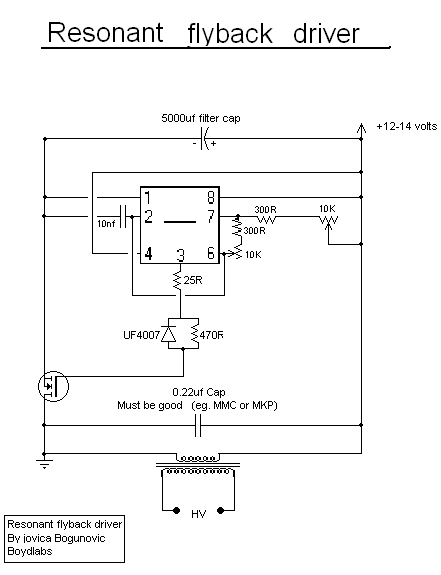

Get driver of this cool circuit
[1]
It is the old nerectified AC type . This one isn't usually good for anything over 30kV, because it will flash over soon (and also because it has usually low number of turns on its secondary winding and thus it is difficult to get high voltages out of it). However it is often suitable for higher power outputs than the other types. Found in old TVs.
[2]
Is probably the best one. Its secondary winding is divided into sections, which are separated by diodes, so there's just little AC voltage present, which makes insulating it easier, so it can output much more voltage than type
[1]
(voltages of 60kV and more are often possible). Found in newer TVs.
That transformer is ideal HV source for tesla.
[3]
Is the same as
[2]
except it has high voltage capacitor on its output, which makes it nearly useless for drawing arcs (because instead of an arc, you get a series of (loud) spark discharges). Found mostly in computer monitors.
How to find high voltage negative pin on your flybak
>
Before you can make any sparks with your flyback, you must find the high voltage negative pin. If you have the old type flyback without diode, it's easy. You can find it with an ohmmeter, the secondary winding will have anywhere from few tens to few thousands ohms.
If you have the new potted type with build-in diodes, it can't be measured with an ohmmeter, because the diodes starts conducting at ~20V. For this purpose, connect a positive voltage of about 30V (three 9V's in series) to the flyback output wire, and measure a voltage between negative output of the power supply and all pins on the flyback's base. The pin that gives the most voltage will be your negative output, which you should in all cases connect to the mains ground.
>Some drivers for flyback (the schemes are designed for [1][2][3])<
[1]
This is one of the simples ways of running a flyback outside of a tv . I highly reccomend building this driver first, to familiarise your self with the suprises of HV. The resistors are rated at 2watt each, out put will vary according to input voltage and type of flyback used, I recomend using old stlye flybacks for this driver.
More
[2]
On alot of websites you will find a schematic of a 555 runnig astable and pulsing a mosfet, this curcuit should not be build as it is very uneffiecient and unstable. Instead build the following one, which has a very high effiency, and a high output voltage. I have made a flyback do 110kv with this type of driver.As you can see there are some diferences in my design compared to the normal astable, the first thing you notice is that there is a wierd gate waveform shaper, all this does is ensure a slow turn on and a very fast turn off, inturn preventing the mosfet blowing at high duty cycles, and the second is that there is a quasi resonant capacitor across the primary
More

[3]
The next flyback driver is By far the most powerful and efficient. ZVS stands for 'Zero voltage switching', which bascicly means that when there is zero volts across the mosfet it turns on and then lets current trough,this inturn causes very little heating, so for example if you ran it of 12volts the mosfets would only produce minimal heat. The heat that is produced comes from the transistors non ideal Drain to Source resistance, so getting a mosfet with very Little RDS(on) is very important, examples of such a mosfet would be the irfp250 which is used in the original design by mazilli.
More

For any asks about site or proposals, email me: shine_spirit@yahoo.com

